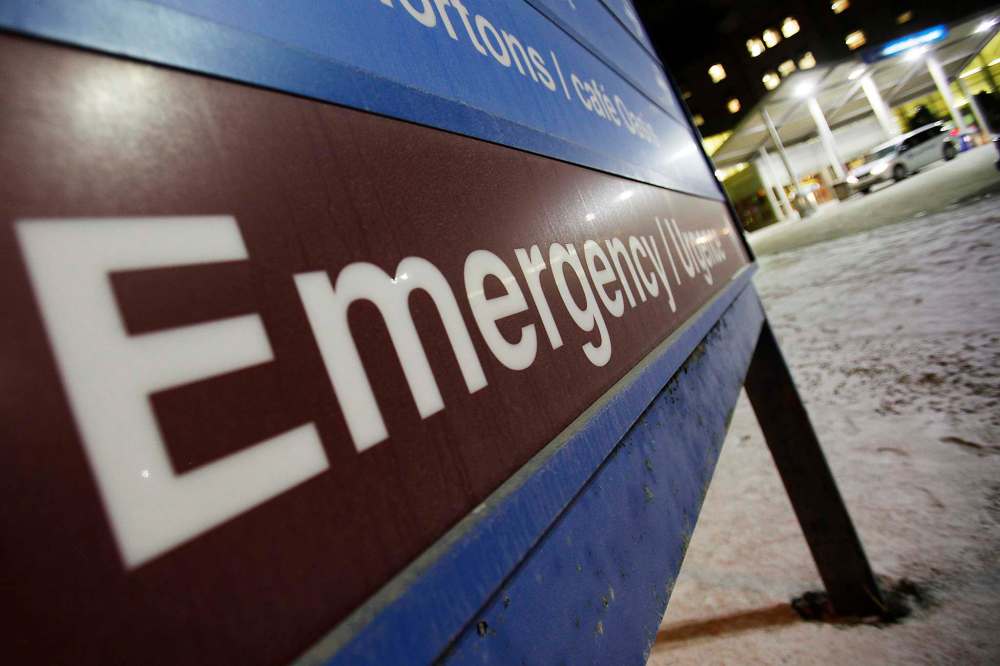How long is too long in the ER?
Advertisement
Read this article for free:
or
Already have an account? Log in here »
To continue reading, please subscribe:
Monthly Digital Subscription
$0 for the first 4 weeks*
- Enjoy unlimited reading on winnipegfreepress.com
- Read the E-Edition, our digital replica newspaper
- Access News Break, our award-winning app
- Play interactive puzzles
*No charge for 4 weeks then price increases to the regular rate of $19.00 plus GST every four weeks. Offer available to new and qualified returning subscribers only. Cancel any time.
Monthly Digital Subscription
$4.75/week*
- Enjoy unlimited reading on winnipegfreepress.com
- Read the E-Edition, our digital replica newspaper
- Access News Break, our award-winning app
- Play interactive puzzles
*Billed as $19 plus GST every four weeks. Cancel any time.
To continue reading, please subscribe:
Add Free Press access to your Brandon Sun subscription for only an additional
$1 for the first 4 weeks*
*Your next subscription payment will increase by $1.00 and you will be charged $16.99 plus GST for four weeks. After four weeks, your payment will increase to $23.99 plus GST every four weeks.
Read unlimited articles for free today:
or
Already have an account? Log in here »
Hey there, time traveller!
This article was published 07/04/2017 (3178 days ago), so information in it may no longer be current.
Emergency departments in Canada are very busy places. Every year, Canadians make about 16 million visits to emergency rooms and more than one million Canadians are admitted to hospital through emergency departments.
Given how complex it is to assess, treat and admit this large and variable population to hospital, it likely comes as no surprise nearly all emergency department patients spend some of their time in hospital waiting.
Emergency-department wait times are a matter of concern for many Canadians. We wonder whether we, or our loved ones, will have to wait in pain or discomfort for hours before being seen. Or if a life-threatening condition could get worse while we wait.

Let’s face it — most of us have been there, wondering what’s taking so long and hoping they’ll call out our name next.
No one likes waiting, especially for urgent care.
Several research studies have explored the factors that contribute to wait times. A few studies have shown emergency departments can become overwhelmed by the sheer number of patients arriving for care. Emergency medicine clinicians and leaders often point to hospital overcrowding as the main culprit for longer waits because patients who are waiting to be admitted to hospital occupy stretchers that would otherwise be available to new patients.
These observations highlight important opportunities for improving wait times. One aspect of emergency care that has not been well studied is the time it takes to assess patients’ conditions once they have been seen by a practitioner in the emergency department.
How long patient assessment takes depends partly on how sick the patient is, but can also be influenced by other factors, such as the need for blood tests, X-rays or consultation with other health-care specialists.
So how long do we wait for care?
A recent study led by Dr. Malcolm Doupe at the Manitoba Centre for Health Policy provides a detailed picture of the many factors affecting Winnipeg’s emergency department wait times — and also studies the patient assessment period for the first time.
The study team used the relatively new Emergency Department Information System (EDIS) to track patients as they move through emergency from their initial assessment (triage) to treatment and then to hospital admission or discharge back to the community.
They found Winnipeg emergency departments are functioning moderately well in most instances, even though they are often at more than 100 per cent capacity during daytime hours. Across all types of emergency departments, half of the patients had a visit time of 5.1 hours or less. With a national wait time average of 4.4 hours for emergency departments, there’s clearly plenty of room for improvement.
It was better news for urgent care.
The study corroborated many findings from previous studies and found wait times were very short (a median wait time of six minutes) for those who needed care immediately. For less-urgent conditions, wait times varied and depended on how many higher urgency patients were receiving care and how many other lower urgency patients were waiting.
The study’s striking finding was the importance of the diagnostic testing process in determining wait times — a new piece of evidence that will help us find solutions.
Diagnostic tests are an essential part of an emergency doctor’s work, but when tests and scans were ordered, wait times for other patients began to climb significantly. For example, Winnipeg’s emergency departments had periods of time when up to 45 per cent of treatment areas were occupied by patients waiting for X-rays or other tests. During these peak periods, wait times for patients with moderate to less-urgent conditions could increase from 15 minutes to as much as five hours.
These findings indicate that new strategies to shorten wait times should now be considered.
Could processes within the emergency department be streamlined to reduce the time it takes to get tests done? Are diagnostic tests quickly available at all hours and at all emergency departments? Are community-based providers sending patients to emergency departments to access diagnostic tests that would best be done in doctors’ offices?
Bringing about improvements to wait times in emergency departments will require collaboration and new approaches between leaders and experts in emergency medicine. But there’s no reason we can’t get there. Patients deserve no less.
Alan Katz is an expert advisor with EvidenceNetwork.ca and director of the Manitoba Centre for Health Policy. Jennifer Enns is a postdoctoral research fellow at the Manitoba Centre for Health Policy.



